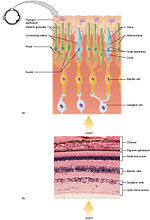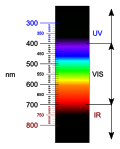Melanopsin is a type of photopigment belonging to a larger family of light-sensitive retinal proteins called opsins and encoded by the gene Opn4. In the...
39 KB (4,525 words) - 07:01, 5 April 2024
Intrinsically photosensitive retinal ganglion cell (redirect from Melanopsin-containing ganglion cell)
(ipRGCs), also called photosensitive retinal ganglion cells (pRGC), or melanopsin-containing retinal ganglion cells (mRGCs), are a type of neuron in the...
26 KB (3,118 words) - 05:44, 25 July 2024
light-dark cycles. He also described the role of melanopsin in ipRGCs. Using a rat melanopsin gene, a melanopsin-specific antibody, and fluorescent immunocytochemistry...
30 KB (3,431 words) - 20:02, 10 September 2024
Opsin (section Melanopsin)
visual transduction cascade. Another opsin found in the mammalian retina, melanopsin, is involved in circadian rhythms and pupillary reflex but not in vision...
83 KB (8,995 words) - 19:00, 26 August 2024
example, melanopsin has an absorption range of 420–540 nm and regulates circadian rhythm and other reflexive processes. Since the melanopsin system does...
37 KB (4,028 words) - 17:13, 4 October 2024
the intrinsically photosensitive ganglion cells of the retina is called melanopsin. These cells are involved in various reflexive responses of the brain...
26 KB (2,939 words) - 03:11, 2 September 2024
(born 29 June 1965) is an American neuroscientist and the discoverer of melanopsin, an opsin found in specialized photosensitive ganglion cells of the mammalian...
15 KB (1,673 words) - 16:29, 1 September 2024
it is directly collected by these RGCs. The RGCs use the photopigment melanopsin to absorb the light energy. Specifically, this class of RGCs being discussed...
27 KB (3,166 words) - 22:57, 1 July 2024
Visual cycle (section Melanopsin visual cycle)
rod and cone pigments, melanopsin has the ability to act as both the excitable photopigment and as a photoisomerase. Melanopsin is therefore able to isomerize...
11 KB (1,373 words) - 00:19, 8 November 2023
the primary factors affecting the circadian rhythm is the excitation of melanopsin, a light sensitive protein that absorbs maximally at 480 nm, but has at...
25 KB (2,787 words) - 19:58, 5 October 2024






